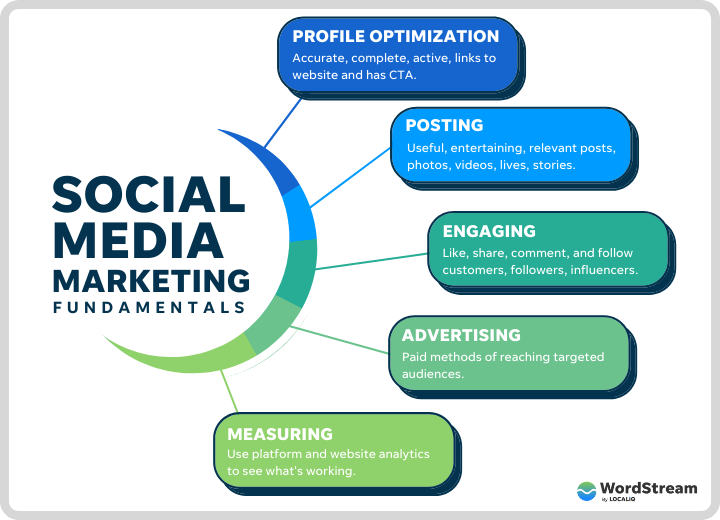Social media marketing is a great way to engage with your audience. It can also help you increase brand awareness and boost sales.
But it’s important to have a clear social media strategy. It’s important to pick the right channels, create compelling content, and measure your results.
This free template makes it easy to organize your social media strategy in a visual format.
1. Social Media Overview
Social media is a powerful tool for communicating with your audience. It can be used to share information about your company, products and services in a way that is both engaging and memorable. It can also be used to gather feedback from your customers.
Whether you are using social media for business-to-business (B2B) or consumer-facing businesses, it is important to set clear goals and plan how you will use social media to reach those goals. Some companies may be focused on audience growth or brand awareness, while others might want to drive measurable sales from social media.
This presentation template is designed to help you create custom diagrams related to your social media marketing strategy. It includes several sample diagram layouts that replicate a tweet page and can be edited to suit your needs. It can also be easily converted to an infographic template with Lucidchart.
2. Social Media Analysis
Social media analysis is a process of tracking and measuring the impact of your social media marketing efforts. This is done by analyzing the behavior of your audience and identifying their needs and preferences. This information can be used to improve your marketing campaigns and drive more sales.
Moreover, it can also help you identify your potential customers and understand their buying models. By doing this, you can identify the best products and services to offer to them.
The content you post on your social media accounts is the core of your marketing strategy. It reflects the message that your brand wants to deliver and determines whether your target audience is receiving it. It is also important to track the performance of your social media content. This is done by analyzing the number of clicks and the overall engagement of your content. It is also a good idea to compare your performance to that of your competitors.
3. Competitive Analysis
A competitive analysis is a vital component of any social media marketing strategy. This is because it allows you to compare your performance to that of your competitors, and identify areas where you have opportunities for improvement.
Your competitors are businesses that offer the same or similar products or services as you do. You can find them by searching for keywords related to your business. However, don’t limit yourself to the results that appear on search engines; also search for competitors on the social networks you use.
Once you’ve identified your competitors, write down their channels, account handles, followings, content formats, and content pillars. You can then create a Google Sheet and link it to your presentation to give stakeholders a detailed look at what’s working (and not) for your competitors. You can even add a column for the metrics you’re tracking to benchmark your performance against those of your competitors.
4. Phase 1
As a business, you need to have a clear strategy to achieve your goals. That’s especially true in a social space that changes by the day with newsfeed algorithm updates and new audiences ready for something fresh.
The first step in your social media strategy is to understand who you’re speaking to. Use customer profiles and demographic data to build out a picture of your ideal buyer, then work to develop a voice and tone that will resonate with them.
Having a clear plan for your social media marketing will help you to create better content that meets the needs of your audience and drives results. Using a template will also save time with professional formatting and design. These templates include great slides for showcasing your social media strategy, including competitor analysis and a visual content calendar. They’re perfect for presenting your social media strategy to stakeholders and clients.
5. Phase 2
Social media is a rapidly evolving space. Keeping up with new trends and algorithms is crucial for business owners in order to find the right audiences to market to.
Creating a social media strategy will allow you to make more informed decisions about how and when you use different types of content, what your social media post schedule should be, and what your recurring posts should look like. This will help you develop your content mix, which is a key component of any successful marketing campaign.
You can also use your social media strategy to define and set SMART goals. Ideally, your social media goals should complement and align with the business goals you’ve defined for your entire company. For example, if you see an increase in customer service requests from your social media channels, that can provide important insight to your product and merchandising teams, helping them create more customer-centric roadmaps.
6. Budget
When drafting a social media marketing strategy, it’s important to include a budget. This can help you track your progress and ensure that you are putting your money where your mouth is. Creating a detailed budget will also allow you to measure your return on investment and make changes when necessary.
When it comes to budgeting, it’s best to start small and build your presence over time. Focus on organic management, and only add paid ads when you have a large enough following to generate conversions. This will reduce your risk of wasting ad dollars.
Additionally, be sure to consider your content marketing budget when drafting a social media marketing strategy. According to Sprout’s 2022 Index, 34% of consumers want to see more content that highlights a brand’s personality. This can boost engagement and inspire customers to buy from you over the long term.
